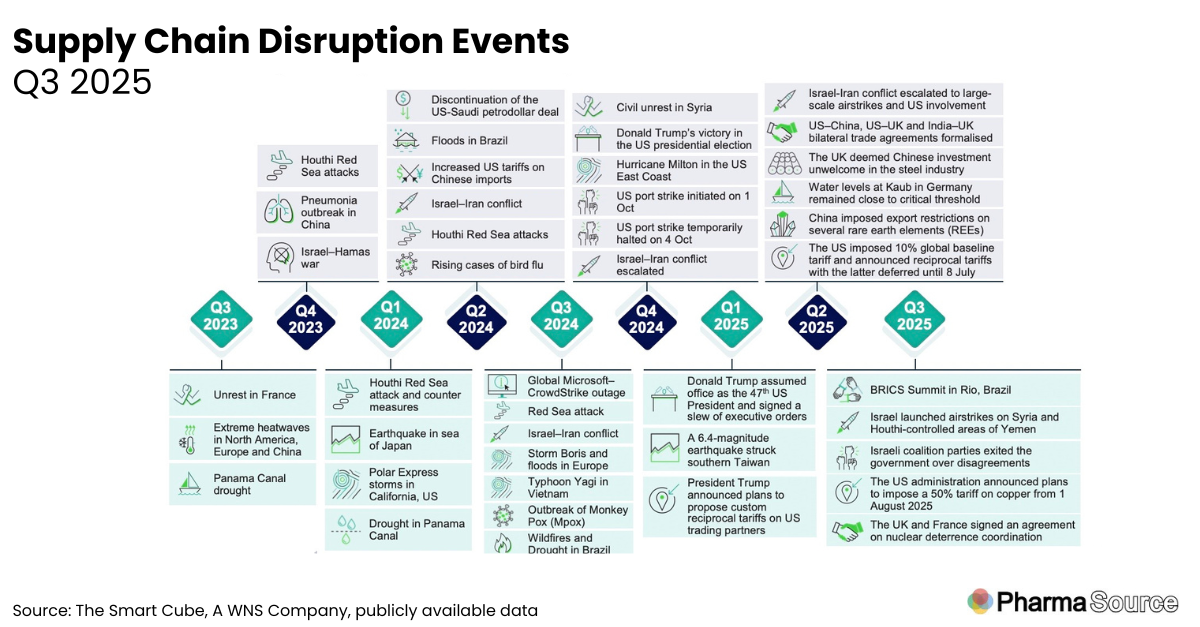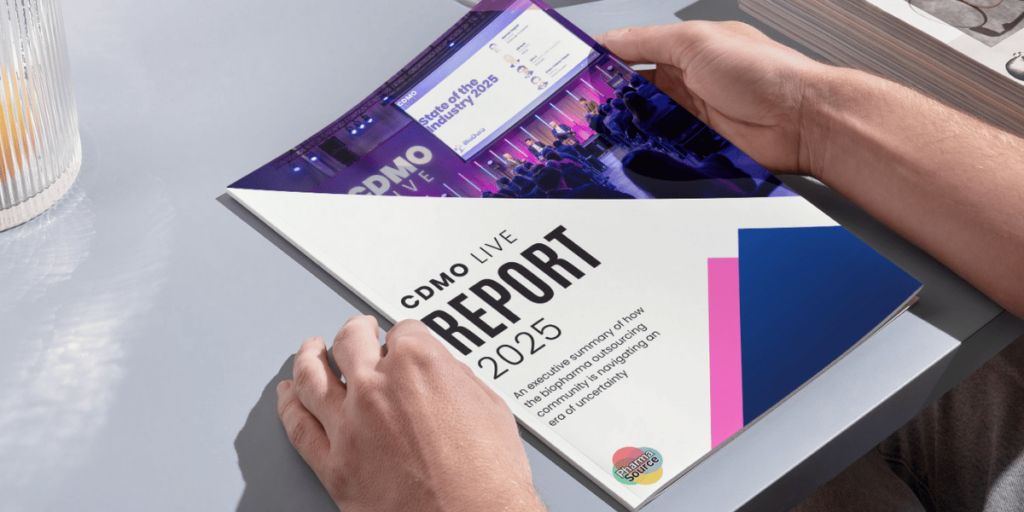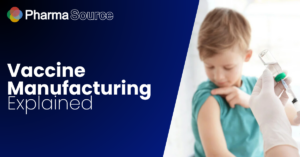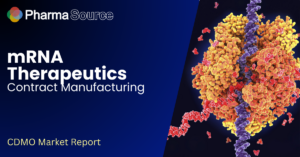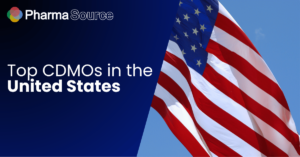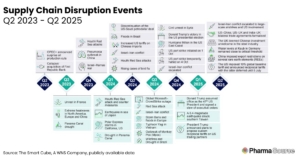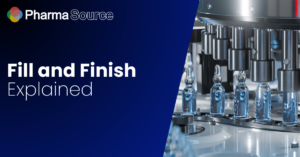This report summarises the key factors driving price changes in Q3 2025:
- In July 2025, the US president announced plans to impose new tariffs effective 1 August 2025; the tariffs will affect over 150 countries, with initial rates ranging from 20–40% on various goods
- Pharmaceutical imports are expected to face initial low tariffs, which could rise as high as 200% over time; companies will be given a one-year grace period to relocate production to the US before the full tariff is applied
- The US administration also introduced a 50% tariff on copper, aluminium and stainless steel, impacting the manufacturing of biological products and medical devices
- In June 2025, the EU barred China-based companies from bidding on public medical device contracts exceeding $5.8 million, in a bid to encourage fairer market access for EU-based suppliers.

Biologics contract manufacturing
Biologics CDMO prices are expected to face increased upward pressure as newly proposed US tariffs on over 150 countries raise input costs and heighten global trade uncertainty.
The global biopharma CMO market is forecast to grow at a CAGR of 10.3% from 2025 to 2030, due to which the cost of services is expected to increase
- Pharma CDMOs are increasing their capacity to meet the rising demand and improve their service offerings.
In July 2025, the US president announced plans to impose new tariffs effective 1 August 2025, which is expected to affect over 150 countries, with initial rates ranging from 20–40% on various goods; moreover, these tariffs are expected to apply across multiple sectors, including pharmaceuticals and semiconductors.
Pharmaceutical imports are expected to face initial low tariffs, with the possibility of these tariffs rising as high as 200% over time; companies will be given a one-year grace period to relocate production to the US before the full tariff is applied
- The 200% tariff warning on pharmaceuticals is likely to raise drug prices for US consumers, particularly for those manufactured overseas; this would affect major pharmaceutical companies including Eli Lilly, Merck and Pfizer.
- Brazil will face a 50% tariff, while Canada, Mexico and the EU will be subjected to tariffs ranging from 30–35%
- The EU has prepared counter-tariffs on $84 billion worth of US goods, which will be enacted if the US moves forward with these tariff measures.
Bioprocessing supply
Bioprocessing supply costs remain mixed, as rising metal tariffs drive up input prices, while the recent decline in oil and polymer prices provides some relief.
The global bioprocessing supply costs, particularly for single-use systems, are showing mixed trends
- In June 2025, polypropylene (PP) prices in APAC declined 0.2% M-o-M, mainly due to ample supply and a decrease in downstream packaging and construction demand
- US HDPE prices fell 1.8% M-o-M in June 2025, mainly due to healthy regional supply; however, the prices are expected to increase in July 2025, with an expected uptick in downstream demand (driven by restocking ahead of the Atlantic Hurricane season)
Ongoing tensions in the Middle East are likely to impact oil prices and subsequently affect energy-related utilities and CDMO operating costs (including resin and polymer feedstocks, such as PE, PP and EVA); this may put pressure on biologics manufacturing margins
- However, oil prices have come down by 11.5% (from $75.1/barrel on 18 June 2025 to $66.5/barrel by mid-July 2025), following a ceasefire between Israel and Iran, and overproduction by OPEC+ countries, which has eased some of the earlier price pressures
- Nonetheless, the situation needs to be continuously monitored, as any flare-ups in the region could lead to further price volatility, impacting global energy markets and related industries
In July 2025, the US administration announced a 50% tariff on copper (effective 1 August 2025); moreover, prior to this, tariffs on steel and aluminium were increased in June 2025 from 25% to 50% for all countries except the UK, which remains at 25% under an interim agreement
- These tariff hikes are likely to increase prices for bioprocessing equipment, including stainless-steel components such as bioreactors, heat exchangers and piping
Cell and gene therapy (CGT)
The global CGT manufacturing market is estimated at $15.1 billion in 2025 and is expected to reach $160.0 billion by 2035, representing a CAGR of 26.6% during the forecast period.
Sustained demand for CGT outsourcing has prompted suppliers to expand their capacity and capabilities through partnerships.
- In July 2025, Cell and Gene Therapy Catapult (a UK-based innovation and technology organisation), Cellular Origins (a UK-based company focused on scalable robotic manufacturing) and Resolution Therapeutics (a UK-based clinical-stage biopharmaceutical company) formed a consortium to develop a fully automated, scalable cell therapy manufacturing platform.
- This platform aims to meet the rising demand for cell and gene therapies and address the manufacturing bottleneck in the industry
Furthermore, tariffs announced by the US administration on imports from other countries in July 2025, including a 50% tariff on copper, will directly increase costs for CGT manufacturers, particularly for raw materials and critical components
- This is likely to result in higher production expenses, longer manufacturing timelines and higher treatment prices, potentially impacting the affordability and scalability of cell and gene therapies.
Regulatory compliance, submission and audit
Global pharma companies, particularly those based in low-cost countries, may need to allocate additional resources to comply with the stringent regulatory standards set by international bodies, especially the US FDA; this heightened scrutiny could result in increased compliance expenses, which may ultimately influence their pricing strategies.
- In July 2025, Aurobindo Pharma (an India-based pharma company) recalled 4,608 bottles of Acetaminophen Tablets in the US due to deviation from cGMP, as reported by the USFDA; the affected lot was recalled due to consumer complaints regarding tablet discolouration (brown surface on tablets).
Small molecule manufacturing, Chemicals and APIs
The global API market is estimated at $238.4 billion in 2025 and is forecast to reach $405.1 billion by 2034, registering a CAGR of 6.0% during the forecast period.
The newly (July 2025) announced US tariffs on pharmaceutical imports will directly increase the cost of APIs, especially those sourced from major suppliers, such as India and China; this is likely to result in higher input costs for US-based manufacturers and subsequently increase the prices of finished pharmaceuticals.
- With a one-year grace period before full tariffs (upto 200%) are enforced, API suppliers and US-based buyers may try to diversify or reshore supply chains; however, the market could experience input price inflation, supply disruptions and longer lead times in the short term.
- These tariffs could also trigger retaliatory measures from affected countries, further complicating the global pharmaceutical supply chain and raising the risk of drug shortages or market volatility.
In July 2025, API prices surged mainly due to logistical issues, including port congestion in APAC and Europe, which caused delays and increased freight costs.
APU / Drug discovery and clinical trials
In June 2025, the USFDA proposed a new priority review pilot program to expedite drug reviews for products addressing US “national interests,” such as health crises or national security, aiming to reduce review time to 1 or 2 months
- The program is still in the pilot phase, and if fully implemented, it could streamline submissions and regulator communication, enhancing efficiency, shortening trial timelines and potentially reducing costs.
- However, short-term vendor pricing may remain high due to the demand for expedited services.
- The initiative may prioritise government-chosen therapies, potentially overlooking other promising options in drug discovery.
Medical devices
Medical device components, such as casings, frames and structural elements, commonly use stainless steel and aluminium alloys.
- In July 2025, the US administration announced a 50% tariff on copper (effective 1 August 2025) and, in June, raised tariffs on steel and aluminium from 25% to 50% for all countries except the UK; this is likely to further increase prices for medical devices that rely on copper, stainless steel and aluminium components for casings, frames and critical structural parts.
- Additionally, new tariffs on semiconductor imports, which are expected to take effect from 1 August 2025, are expected to drive up costs for electronic medical devices and diagnostic equipment that depend on advanced chip technology.
In June 2025, the EU announced that Chinese companies are to be barred from bidding on public medical device contracts worth more than $5.8 million; additionally, another rule states that no successful bid can have more than 50% of its inputs from China.
- The move aims to counter China’s exclusion of EU-made medical devices from its government contracts and promote fairer market access for EU suppliers.
Analytical laboratory and processing equipment
Prices for capital equipment are expected to rise moderately, driven by increased input costs for processing equipment, while laboratory equipment prices remain stable.
- In June 2025, the US PPI for Analytical Laboratory Instruments remained stable M-o-M, indicating that input costs and pricing pressures for laboratory equipment did not experience significant changes during this period.
- The PPI for Processing Equipment, including Pumps and Compressors, rose 2.9% M-o-M in June 2025, indicating a notable increase in input costs and pricing pressures for manufacturers.
Lab supplies and services
Primary packaging prices are expected to rise due to higher aluminium prices and the US PPI for glass, despite the anticipated decline in PVC and PET prices
Plastic ware, glassware and reagents
- Lab supply prices are expected to remain stable, driven by falling HDPE costs and oversupply, despite a marginal uptick in US chemical input prices
- ~65% cost of manufacturing lab supplies is attributed to raw materials, including HDPE, glass, polypropylene, etc.
- The global HDPE market saw a decline in June 2025, especially in the US and APAC.
- While HDPE prices in the US decreased 1.8% M-o-M In June 2025, in APAC they decreased 0.5% M-o-M (to $1,125.8/tonne); the prices in Europe remained unchanged during the period.
- The main factors behind this decline are reduced demand, lower feedstock (ethylene) prices and oversupply, all of which have lowered production costs for HDPE.
- Further, the US PPI for chemicals and allied products increased 0.3% M-o-M in June 2025.
Primary packaging
PVC/PET, glass and aluminium packaging
Primary packaging prices are expected to rise due to higher aluminium prices and the US PPI for glass, despite the anticipated decline in PVC and PET prices
- Blister packaging for pharma products typically involves raw materials, such as aluminium, PET and PVC, while HDPE is used for bulk drums.
- While PVC prices in the US rose 5.3% M-o-M in June 2025 and PET prices declined in Europe and the US by 2.8% and 1.8% respectively, prices for both materials are expected to fall further in July 2025 mainly due to anticipated decreases in feedstock (ethylene) prices.
- Aluminium prices increased 3.0% M-o-M in June 2025, mainly due to fall in stocks at the LME warehouses and increase in feedstock (alumina) prices due to upstream (bauxite) shortages.
Biologics and injectable drugs are typically packaged in glass or plastic vials/ampoules
- The US PPI for flat glass manufacturing increased 1.2% M-o-M in June 2025; this increase may lead to a potential price rise across the broader flat glass category.
This category update is powered by The Smart Cube, a WNS Company. For more procurement intelligence, visit Amplifi PRO.

